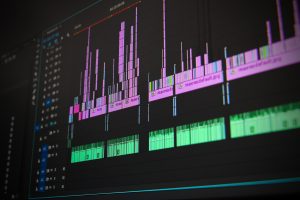5 AI in the Arts
Christina Tallon, Ph.D. & Amelia Winger-Bearskin
Music
 AI tools can be used in many aspects of sound studies, including the generation of musical materials for novel compositions and improvisations, audio production and engineering, and even healthcare and ecology. Using a process known as music information retrieval (commonly abbreviated as MIR), interested parties are able to analyze many characteristics of music (including but not limited to tempo, meter, timbral information, instrumentation, tonality/harmonic structure, melodic contours, genre, and mood) to agglomerate large bodies of information about what their listeners prefer, and in which circumstances. The datasets that are created can then be used for a variety of different purposes, including both analytical and generative means. Music streaming services often use AI to analyze their clients’ listening habits and suggest artists, albums, and songs informed by what users have previously expressed a preference for through repeated listenings. While many of these companies tout their ability to deliver more personalized experiences to their clients, in reality, they use their clients’ listening habits to target advertising and listening suggestions in an effort to maximize profits.
AI tools can be used in many aspects of sound studies, including the generation of musical materials for novel compositions and improvisations, audio production and engineering, and even healthcare and ecology. Using a process known as music information retrieval (commonly abbreviated as MIR), interested parties are able to analyze many characteristics of music (including but not limited to tempo, meter, timbral information, instrumentation, tonality/harmonic structure, melodic contours, genre, and mood) to agglomerate large bodies of information about what their listeners prefer, and in which circumstances. The datasets that are created can then be used for a variety of different purposes, including both analytical and generative means. Music streaming services often use AI to analyze their clients’ listening habits and suggest artists, albums, and songs informed by what users have previously expressed a preference for through repeated listenings. While many of these companies tout their ability to deliver more personalized experiences to their clients, in reality, they use their clients’ listening habits to target advertising and listening suggestions in an effort to maximize profits.
The datasets that are created can then be used for a variety of different purposes, including both analytical and generative means. Meanwhile, content creation companies often use these datasets to allow their clients to create royalty-free music for use in advertisements, films, social media, and other situations in which hiring a composer and musicians to perform the works may be cost-prohibitive. Users often pay a monthly fee to access the service, which allows them access to AI models trained on datasets comprised of thousands of compositions, quite often in the public domain (and therefore inherently antiquated), to generate musical materials that may fit within the parameters represented by those works. Some composers use AI to analyze and generate musical materials in accordance with their own personal style, and some performers have used AI to respond to their improvisations in a fluid and adaptable way (or to suggest new musical materials that may have been outside the scope of their practice).
Beyond the analysis and creation of music, a robust understanding of the ways in which humans create, perceive, and interact with sound has led to the use of AI to identify everything from sonic patterns in COVID patients’ coughs to the health of ecosystems based upon the sounds of bark beetles gnawing on pine trees. By critically analyzing our listening habits, we can learn an enormous amount about the hidden structures that underlie the emergent behaviors we observe in the sonic landscapes around us, be they our own preferences and biases, the capitalist structures that often dictate which media we are exposed to and why, or the health of our communities and ecosystems.
Visual Arts
“The term “artificial intelligence” has been colored by decades of science fiction, where machines capable of thinking freely, learning autonomously, and maybe even experiencing emotions have been reimagined in different forms, whether that has been as benevolent as WALL-E or as malevolent as HAL-9000. So it is perhaps not our fault that when we hear about A.I. art, we might picture something that is actually a major misconception of the technology.
The oracular entity we imagine as the maestro behind such artworks is what researchers today would call an “artificial general intelligence,” and while technologists are actively working toward this, it does not yet exist. “I think a lot of people like to ascribe somewhat spiritual qualities to A.I. as it is something beyond human ken, something that is more pure in that way,” A.I. artist and researcher Amelia Winger-Bearskin said. “But it is actually quite messy—it’s just a bunch of nerdy coders and artists that are making stuff.”
- How Did A.I. Art Evolve? Here’s a 5,000-Year Timeline of Artists Employing Artificial Intelligence, From the Ancient Inca to Modern-Day GANs
- We identified some of the earliest developments and key movements in the field today.
- Naomi Rea, December 16, 2021
- https://news.artnet.com/art-world/artificial-intelligence-art-history-2045520

Feedback/Errata